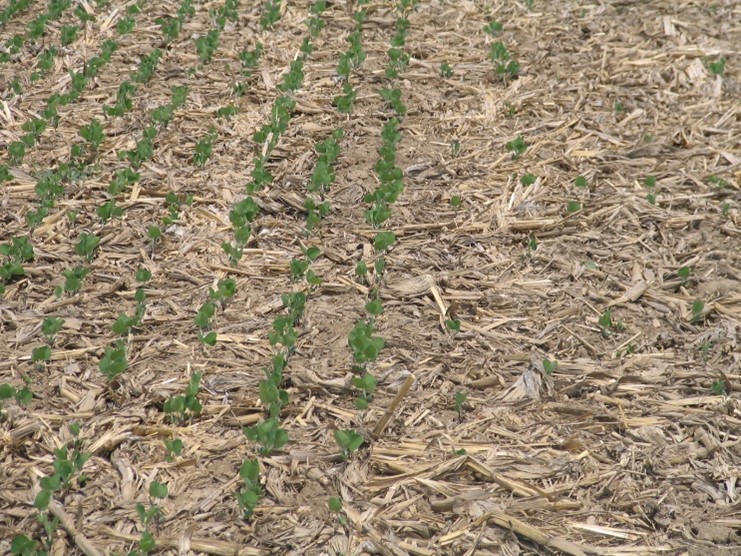A seeding depth of 3.8 cm (1.5 in.) is generally a good target depth for soybeans. Seeding depth when planting early into no-till conditions can often be reduced to 2.5 cm (1 in.) if there is sufficient soil moisture. However, due to the high-water demand for germination, plant 1 cm into moisture (0.5 in.), but not deeper than 6.4 cm (2.5 in.) in total. See figure 1.

Figure 1. Lack of emergence due to shallow planting into dry soil. Left side planted at 4 cm (1.5 in.), right side at 2 cm (0.75 in.)
A newly planted soybean seed is completely dependent on its reserve of energy to push through the soil. In general, larger seeds contain more energy and can be planted slightly deeper than small seeds. When seeding in July (double cropping) it is possible to plant deeper than 6.4 cm (2.5 in.) and still achieve a good plant stand. Because conditions are much warmer in the summer, the seed will have more “push” to emerge from greater depths. With seed drills, precise seed placement is difficult, especially if there is considerable crop residue in the field. Proper seeding depth with a seed drill can be improved by using adequate down pressure, ballast, and the use of a coulter cart. It is important to have good seed-to-soil contact and a closed seed slot. The key is to plant seeds into adequate moisture, but the soil cannot be saturated or seed slot smearing, and compaction will occur. If moisture is not present when seeding with a drill, consider using a planter to get deeper soil penetration, or waiting for rainfall. Varieties differ in their ability to emerge from planting depths greater than 5 cm (2 in.). Seed companies can provide an “emergence score” or hypocotyl length rating, which rates the ability of the seedling to emerge from unusually deep planting.
Research has shown that, when seeding depth is 6.4 cm (2.5 in) or more, plant stands are reduced, see Table 1, Plant Stands at Various Planting Depths. More importantly, yields are also reduced when the seeding depth was greater than 2.0 inches, see table 2, Yields at Various Planting Depths.
No matter the planting date in this study, the best plant stands and yields were achieved with a seeding depth of 3.8 cm (1.5 in).
Table 1. Plant Stands at Various Planting Depths (plants/ac X 1000)
| Planting Depth | April | May | June | Average (plants/acre) |
| 1.0 inches | 129 | 144 | 162 | 145 |
| 1.5 inches | 136 | 142 | 158 | 145 |
| 2.0 inches | 132 | 127 | 150 | 136 |
| 2.5 inches | 107 | 124 | 137 | 123 |
Table 2. Yields at Various Planting Depths (bu/ac)
| Planting Depth | April | May | June | Average Yield (bu/ac) |
| 1.0 inches | 63.1 | 65.8 | 56.0 | 61.6 ab |
| 1.5 inches | 63.3 | 67.3 | 56.1 | 62.2 a |
| 2.0 inches | 61.5 | 62.7 | 54.5 | 59.6 ab |
| 2.5 inches | 59.7 | 62.9 | 53.8 | 58.8 b |
| *Seeding rate was 175 000 seeds/acre in 2020 and 161 000 in 2021. Planting dates: April 22, 2020 and April 26, 2021May 22, 2020 and May 18, 2021June 10, 2020 and June 7, 2021 Variety: RX Response in 2020 and Woden R2X in 2021. | ||||